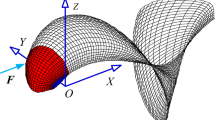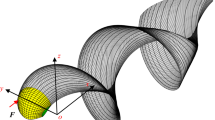Abstract
A finite-element method coupled with analysis of a noncavitating lifting surface was used to assess the performance of a marine propeller, including the thrust, torque, efficiency coefficients, and deflections. The formulation used displacements as unknowns in the structural part and the strength of the vortex as unknowns in the fluid part. A coupled matrix derived from the Bernoulli equation and hydrostatic pressure in terms of the strength, of the vortex enforced coupling between the fluid and the structure. The resulting matrix equation was unsymmetric and nonlinear; a Newton-Raphson procedure was used to solve this equation. The numerical results were compared with test data; computed and measured values agreed satisfactorily. We also investigated the effect of blade thickness on the performance and strength of the propeller. We did not consider the fatigue strengh of the propeller in this analysis.
Similar content being viewed by others
Abbreviations
- a :
-
length of plate
- b :
-
width of plate or beam
- C :
-
chord length of propeller section
- D :
-
diameter of propeller
- E :
-
young’s modulus
- h :
-
thickness of plate or beam
- I :
-
section modulus of beam
- J :
-
advance coefficient (V a /nD)
- K T :
-
thrust coefficient (T/ρn 2 D 4)
- K Q :
-
torque coefficient (Q/ρn 2 D 5)
- L :
-
length of beam
- n :
-
rotational speed of propeller
- P :
-
pitch of propeller
- r :
-
radial coordinate
- R :
-
radius of propeller
- 1/R Y :
-
curvature of plate
- q :
-
density of distribution load
- Q :
-
torque moment of propeller
- T :
-
thrust force of propeller
- u 1 :
-
displacement alongX axis
- u 2 :
-
displacement alongY axis
- u 3 :
-
displacement alongZ axis
- V a :
-
advance speed of ship
- W :
-
central deflection of plate or tip deflection of beam
- Ω:
-
rotation speed, Ω={Ω x , Ω y , Ω x }
- θ:
-
angle of attack (between 0° and 90°)
- ω0 :
-
fundamental natural frequency
- η0 :
-
efficiency (TV a /2nπQ)
- ρ:
-
density of flow
References
Taylor DW (1993) The speed and power of ships. Ransdell, Washington
Cohen JW (1955) On stress calculations in helicoidal shells and propeller blades. Netherlands Research Center T.N.O. shipbuilding and Navigation, Delft Report 21S
Conolly JE (1974) Strength of propellers. Trans RINA 103:139–204
Genalis P (1970) Elastic strength of propellers—an analysis by matrix methods. Ph. D. dissertation. University of Michigan
Atkinson P (1968) On the choice of method for the calculation of stress in marine propellers. Trans RINA 110:447–463
Ma JH (1974) Stresses in marine propellers. J Ship Res 18:252–264
Sontvedt T (1974) Propeller blade stresses—application of finite-element methods. Comput Struct 4:193–204
Atkinson P, Glover EJ (1988) Propeller hydroelastic effects. SNAME on the propeller. ’88 Symposium No. 21, Jersey, NJ
Szantyr JA (1985) A new method for the analysis of propeller cavitation and hull surface pressures. Trans RINA 127:153–167
Zienkiewicz OC (1991) The finite-element method, 4th edn. McGraw-Hill, London
Bathe KJ, Bolourchi S (1980) A geometrical and material nonlinear plate and shell element. Comput Struct 11:23–48
Haisler WE, Stricklin JA (1972) Development and evaluation of solution procedures for geometrically nonlinear structural analysis. J American Institute of Aeronautics and Astronautics 10:264–272
Bathe KJ, Ramm E (1975) Finite-element formulations for large deformation dynamic analysis. Int J Numer Methods Eng 9:353–386
Chang TY, Sawamiphakdi K (1981) Large deformation analysis of laminated shell by the finite-element method. Comput Struct 13:331–340
Sreenivasamurthy S, Ramamurti V (1981) A parametric study of vibration of rotating pre-twisted and tapered low aspect ratio cantilever plates. J Sound Vib 76:311–328
Leissa AW, Lee JK, Wang AJ (1982) Rotating blade vibration analysis using shells. ASME J Eng Power 104:296–302
Kerwin JE, Lee CS (1978) Prediction of steady and unsteady marine propeller performance by numerical lifting-surface theory. Trans SNAME 86:218–253
Singh RK, Kant T, Kakodkar A (1991) Coupled shell-fluid interaction problems with degenerate shell and three-dimensional fluid elements. Comput Struct 38:515–528
Yokoo K, Yazaki T (1973) The design method and chart of the propellers of small ships (in Japanese). Seizando, Tokyo
Chen CS, Wu TU, Chiou YY (1993) Study on the propulsion performance of an improved FRP inshore fishing boat. Master’s thesis, National Taiwan University.
Author information
Authors and Affiliations
About this article
Cite this article
Lin, HJ., Lin, JJ. Nonlinear hydroelastic behavior of propellers using a finite-element method and lifting surface theory. J Mar Sci Technol 1, 114–124 (1996). https://doi.org/10.1007/BF02391167
Received:
Accepted:
Issue Date:
DOI: https://doi.org/10.1007/BF02391167




